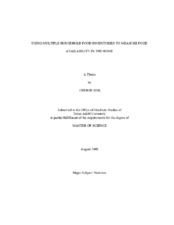| dc.description.abstract | The purpose of this study was to determine the feasibility of conducting multiple household food inventories over the course of 30 days to examine weekly food variability. Household food availability influences the foods individuals choose to consume; therefore, by assessing the home food environment a better understanding of what people are eating can be obtained. Methods of measuring home food availability have been developed and tested in recent years; however most of these methods assess food availability on one occasion only. This study aimed to capture "usual" availability by using multiple assessments.
After the development and pre-testing of the 171-item home observation guide to determine the presence and amount of food items in the home (refrigerator, freezer, pantry, elsewhere), two trained researchers recruited a convenience sample of 9 households (44.4% minority), administered a baseline questionnaire (personal info, shopping habits, food resources, and food security), and conducted 5 in-home assessments (5-7 day interval) over a 30-day period. Each in-home assessment included shopping and fast food activities since the last assessment and an observational survey of types and amounts of foods present. The final in-home assessment included an audio recorded interview on food habits and beliefs.
Complete data were collected from all 9 women (32.8 y +/- 6.0; 3 married; 4 +/- 1.6 adults/children in household; 4 SNAP; 6 food insecure) and their households. Weekly grocery purchases (place, amount, and purpose) use (frequency) varied from once (n=1) to every week (n=5); 4 used fast food 2-3 times/wk for 4 weeks. Quantity and types of fresh and processed fruits and vegetables varied by week and by family. The feasibility of conducting multiple in-home assessments was confirmed with 100% retention from all participants. This methodology is important in that it provided detailed information on intra-monthly variation in food availability. The findings suggest the inadequacy of a single measure to assess food availability in the home. | en |


